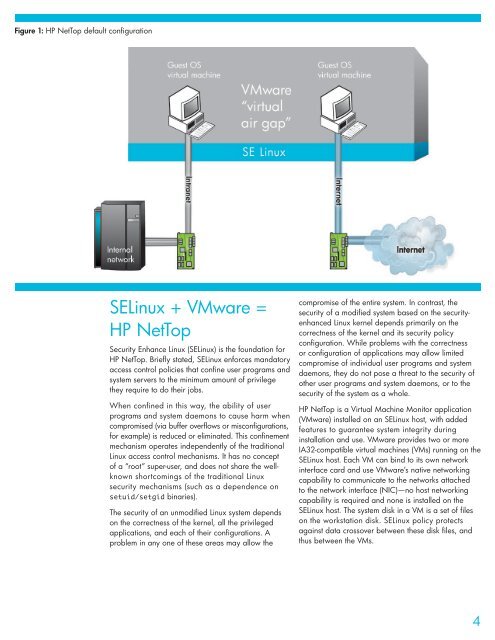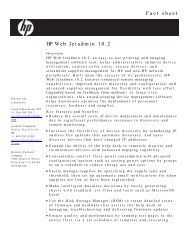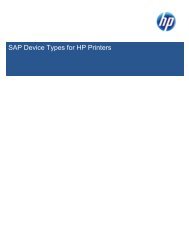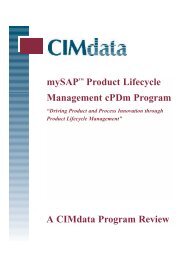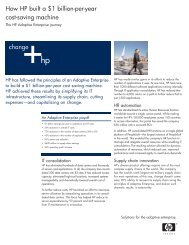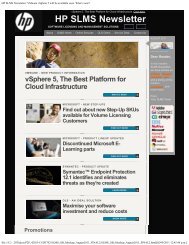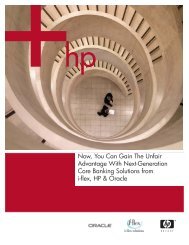HP NetTop - Large Enterprise Business - HP
HP NetTop - Large Enterprise Business - HP
HP NetTop - Large Enterprise Business - HP
Create successful ePaper yourself
Turn your PDF publications into a flip-book with our unique Google optimized e-Paper software.
Figure 1: <strong>HP</strong> <strong>NetTop</strong> default configuration<br />
SELinux + VMware =<br />
<strong>HP</strong> <strong>NetTop</strong><br />
Security Enhance Linux (SELinux) is the foundation for<br />
<strong>HP</strong> <strong>NetTop</strong> . Briefly stated, SELinux enforces mandatory<br />
access control policies that confine user programs and<br />
system servers to the minimum amount of privilege<br />
they require to do their jobs .<br />
When confined in this way, the ability of user<br />
programs and system daemons to cause harm when<br />
compromised (via buffer overflows or misconfigurations,<br />
for example) is reduced or eliminated . This confinement<br />
mechanism operates independently of the traditional<br />
Linux access control mechanisms . It has no concept<br />
of a “root” super-user, and does not share the well-<br />
known shortcomings of the traditional Linux<br />
security mechanisms (such as a dependence on<br />
setuid/setgid binaries) .<br />
The security of an unmodified Linux system depends<br />
on the correctness of the kernel, all the privileged<br />
applications, and each of their configurations . A<br />
problem in any one of these areas may allow the<br />
compromise of the entire system . In contrast, the<br />
security of a modified system based on the security-<br />
enhanced Linux kernel depends primarily on the<br />
correctness of the kernel and its security policy<br />
configuration . While problems with the correctness<br />
or configuration of applications may allow limited<br />
compromise of individual user programs and system<br />
daemons, they do not pose a threat to the security of<br />
other user programs and system daemons, or to the<br />
security of the system as a whole .<br />
<strong>HP</strong> <strong>NetTop</strong> is a Virtual Machine Monitor application<br />
(VMware) installed on an SELinux host, with added<br />
features to guarantee system integrity during<br />
installation and use . VMware provides two or more<br />
IA32-compatible virtual machines (VMs) running on the<br />
SELinux host . Each VM can bind to its own network<br />
interface card and use VMware’s native networking<br />
capability to communicate to the networks attached<br />
to the network interface (NIC)—no host networking<br />
capability is required and none is installed on the<br />
SELinux host . The system disk in a VM is a set of files<br />
on the workstation disk . SELinux policy protects<br />
against data crossover between these disk files, and<br />
thus between the VMs .<br />
4


